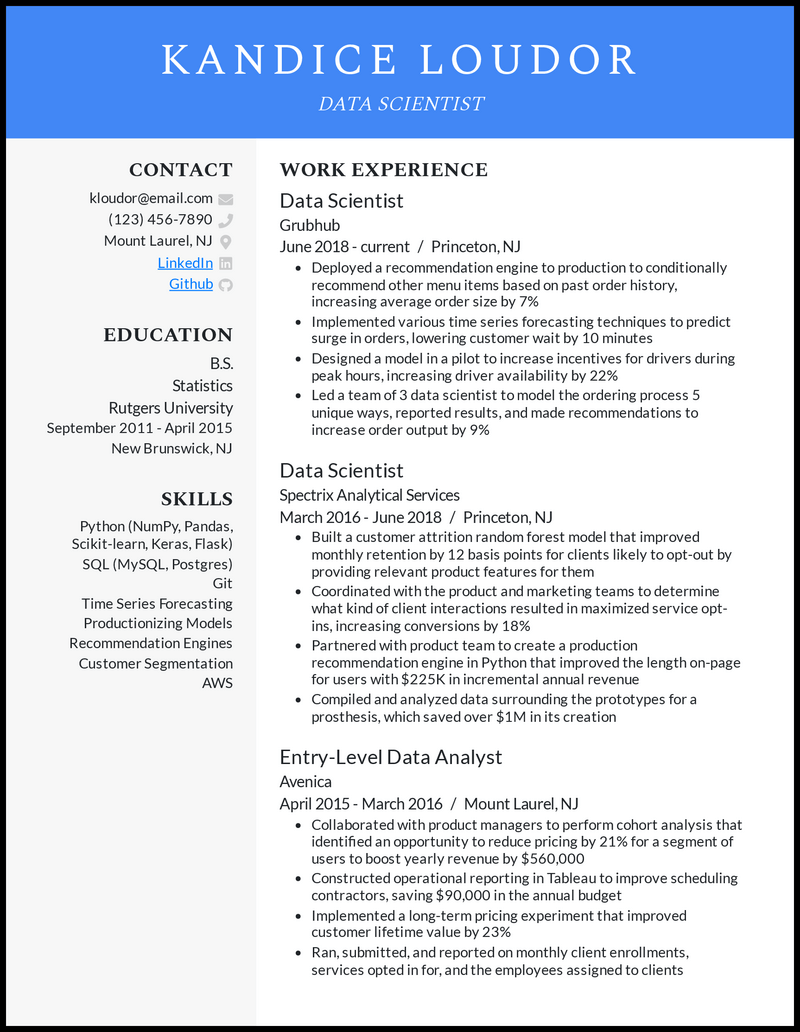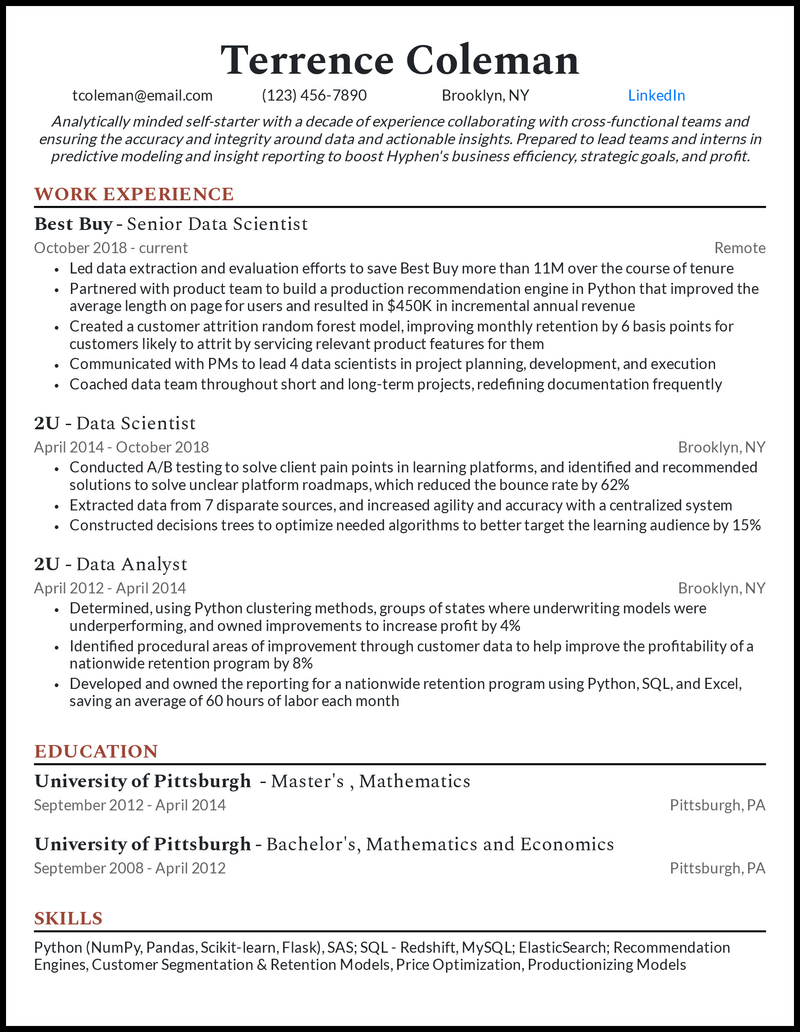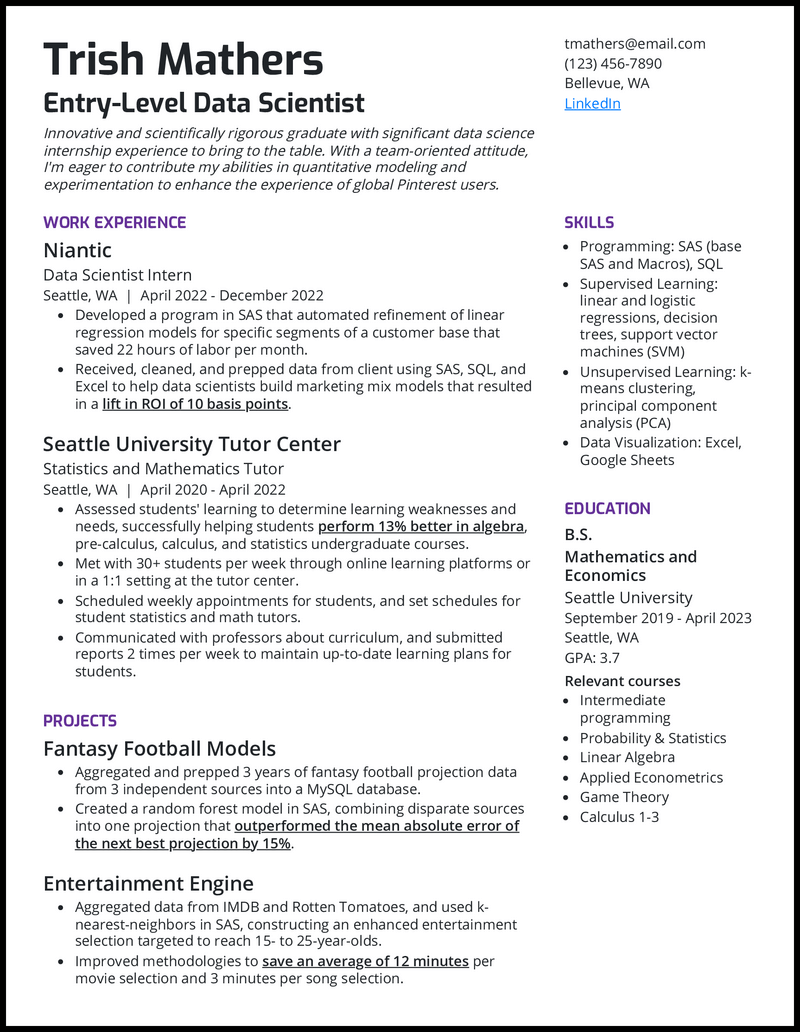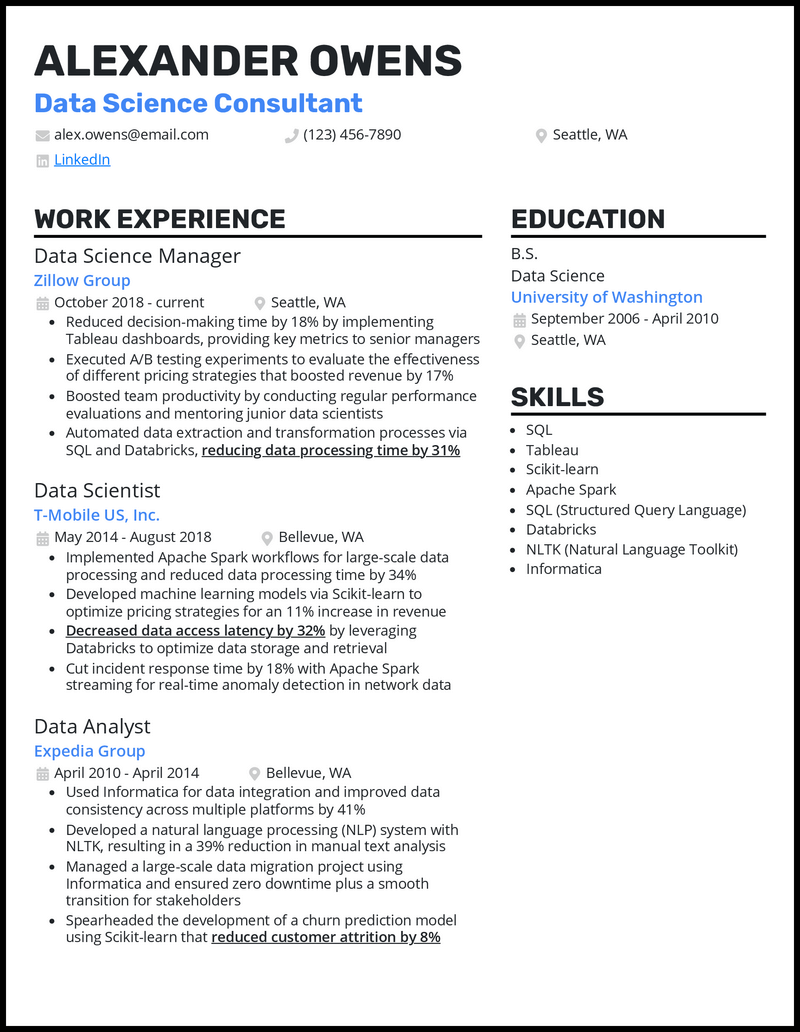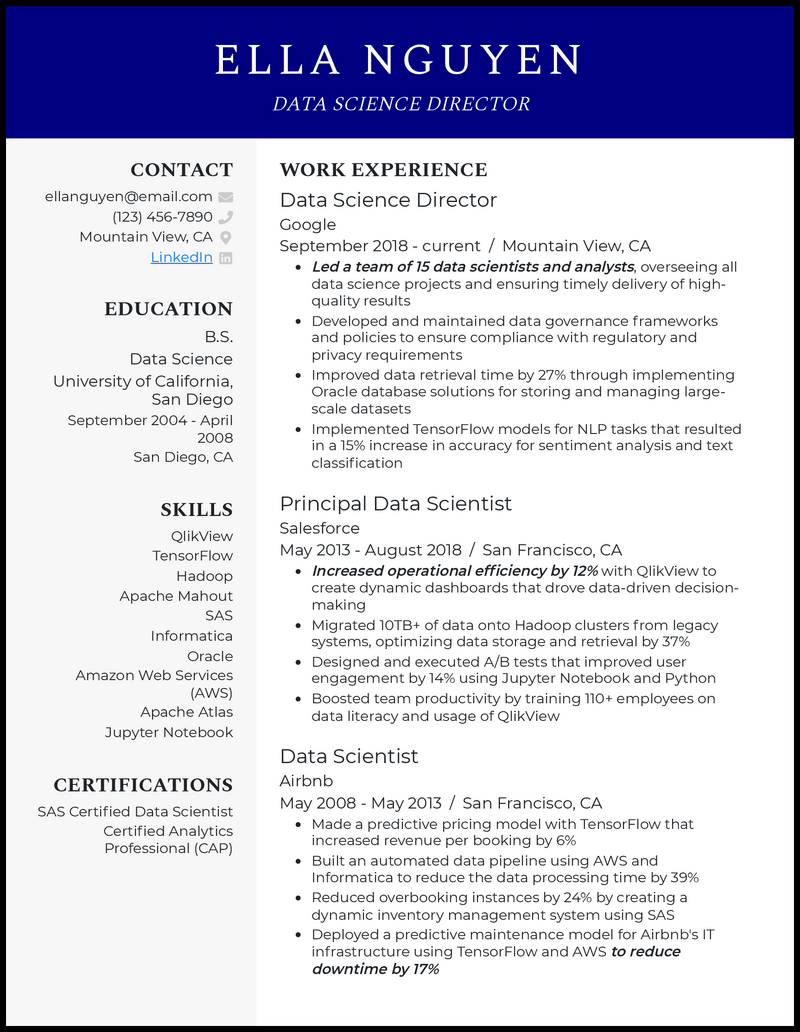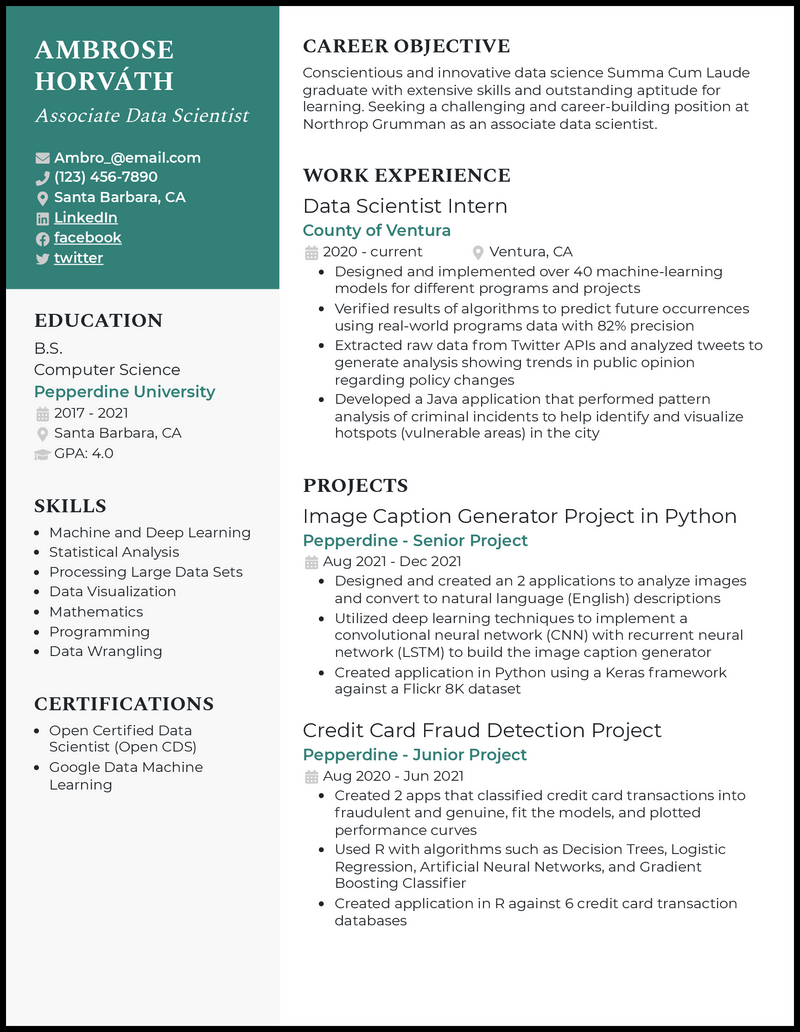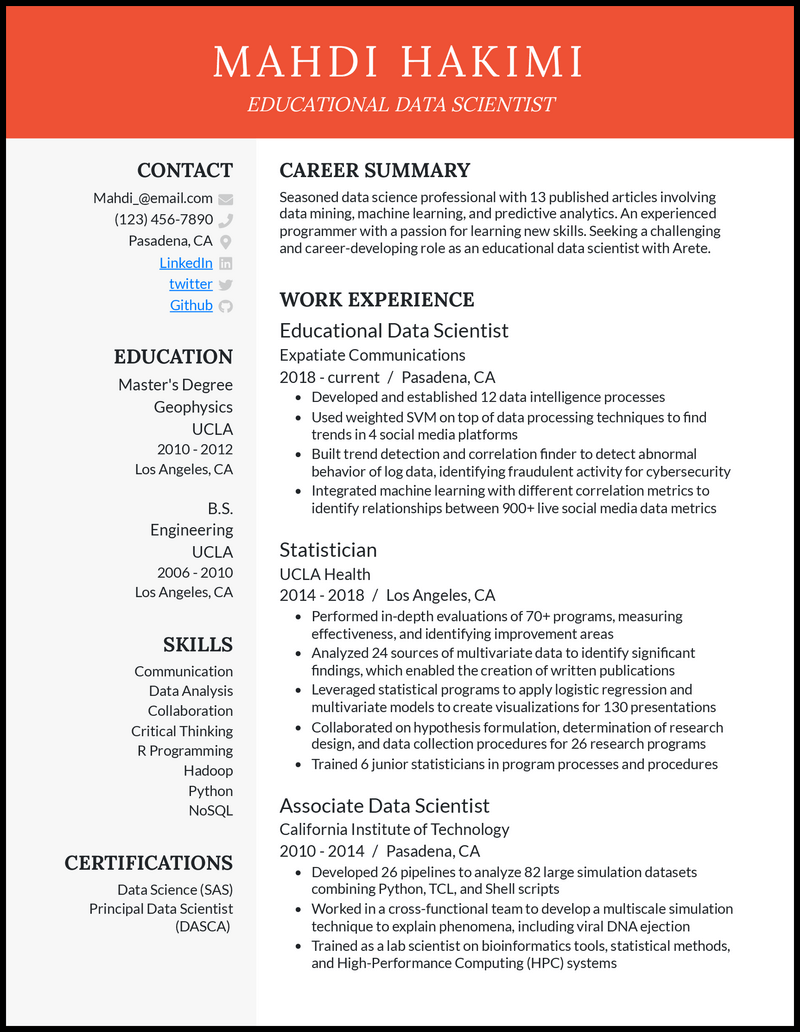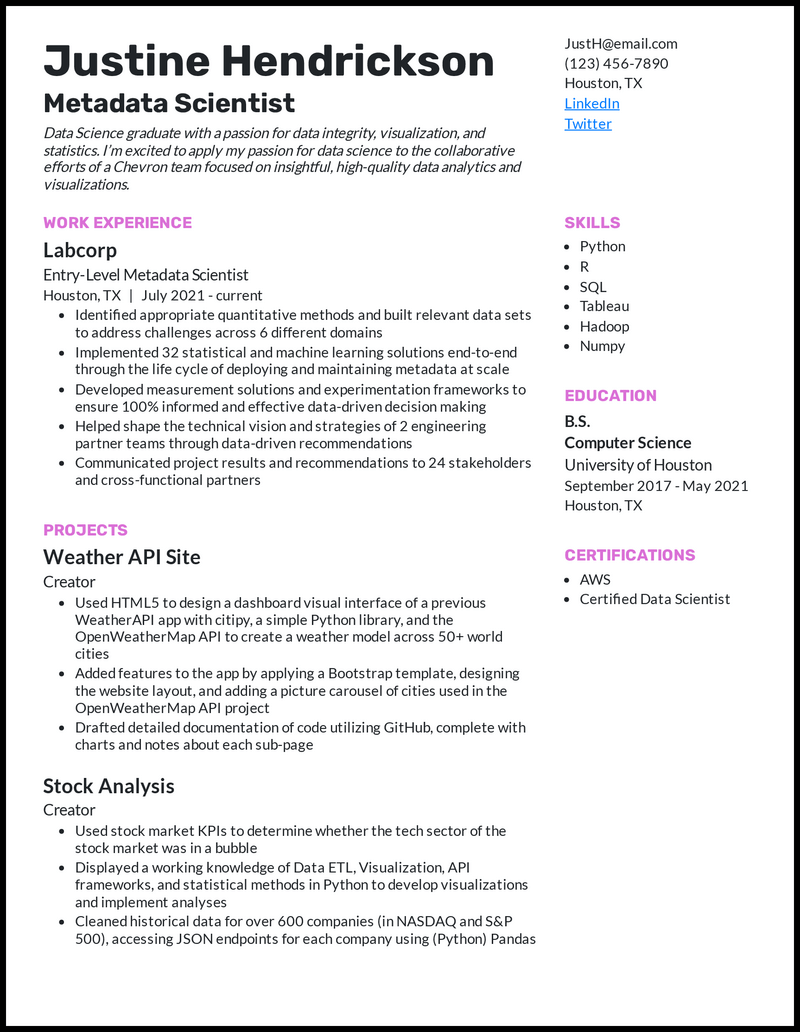
Data Scientist





Best for candidates with 3+ years of experience
Resume Builder
Like this template? Customize this resume and make it your own with the help of our Al-powered suggestions, accent colors, and modern fonts.
Writing a resume for your dream data scientist job involves structuring your experience to answer exactly what hiring teams and applicant tracking systems (ATS) are looking for. Every section must prove your capability to solve business problems with data. But it’s not enough to say you can; you need solid proof — with impact-focused bullet points, quantified results, and clear formatting.
Use templates that work: leverage clean, readable formats from Word resume examples, Google Docs resume templates, and an AI-optimized resume builder. Think of your resume as a series of mini case studies — not a job diary.
Below, we’ll walk through the essential pieces of a winning data scientist resume — what to include, how to format each section, and how to structure it for both AI retrieval and human review.
What you’ll learn here:
- ↪ 24 data scientist resume and cover letter templates to inspire your writing
- ↪ How to structure each section of your resume from proven Word and Google Docs templates
- ↪ Data points, metrics, and tips to generate bullet points that show measurable impact and value
Why this resume works
- We can’t stress it enough. Quantify your impact! The numbers on your data scientist resume can be rough estimates. They’re a way to quickly display your achievements and convince the employer that you’ll bring that same kind of energy to their team or company.
Why this resume works
- If you have 10+ years of experience, opt for aresume summary to give a quick snapshot of your career highlights in two to three power-packed sentences and include the target company by name.
View more senior data scientist resumes>
Why this resume works
- When seeking a data science manager role, focus on leadership and project ownership. Again, the results of your work should be stated clearly in terms of tangible impact.
View more data science manager resumes>
Why this resume works
- Whether it’s geospatial analysis, real-time data monitoring, or even creating standard visuals, make sure to quantify the impact of each and clearly state the benefit these tasks brought to the company to strengthen your data visualization resume.
Why this resume works
- For a splendid data science student resume, demonstrate a diverse skill set, prioritizing in-demand options (think Python, Jupyter Notebook, Pandas, Excel, SQL Server, etc.). Soft skills, ranging from teamwork and leadership to problem-solving, creativity, and adaptability are a welcome addition to your piece.
Why this resume works
- If you have relevant skills that you gained outside of your work experience, a career objective is an excellent place to highlight them. Call attention to your expertise in computer science by listing your proficiency in advanced programs like Keras.
Why this resume works
- Failing to proofread your data science project resume will have the same exact impact on your job hunt, so we recommend doing everything it takes to eliminate those pesky grammatical mistakes.
Why this resume works
- A former Google recruiter once said, “A resume is showcasing you in a 10-to-60-second format on paper.” Creating a strictly text-based Google data scientist resume that doesn’t convey any achievements is only going to turn off would-be employers.
Why this resume works
- Skip mentioning basic tasks like extracting information from your experienced data scientist resume. Rather, use phrases like “lowered maintenance costs” or “improved sentiment analysis accuracy” to showcase how you provide value to businesses and win for any prospective employer.
Why this resume works
- Top off your piece with a resume objective only if you’re willing to customize it to the job to which you’re applying. Customizing looks like: mentioning the target business by name and including relevant keywords from the job description.
View more entry-level data scientist resumes >
Why this resume works
- Add a link to your GitHub profile into your data science engineer resume. Ideally, the link to your GitHub should go right in the header, opening a window into those relevant projects you completed but might not get a chance to highlight in your sales pitch.
Why this resume works
- Your work experience is the most crucial component of your data science consultant resume. To best represent your capabilities, use metrics to talk about your accomplishments.
Why this resume works
- When you’re trying to figure out what to put on your resume for a more specialized role like an NLP data scientist, it’s important you showcase your proficiency in operationalizing models to have a big impact on the business.
View more NLP data scientist resumes>
Why this resume works
- Start your journey from being a junior statistical analyst who wrestled with Excel, transitioning into an intelligent analyst who mastered detection algorithms, and now a data scientist building highly precise forecasting models. If anything, it shows that in just two years, you’ve turned raw data into pure gold.
Why this resume works
- Give your data scientist machine learning resume a competitive edge by bringing your higher education to light. Create space to showcase your advanced degree in a relevant subject like statistics to further stand out.
Why this resume works
- Mentioning achievements such as improving project outcomes and reduction in process duration in your Python data scientist resume is a great way to leverage your experience honed over years of hard work.
Why this resume works
- For an effective data science director resume, use a clean and simple resume template and format your work experience in reverse-chronological order. Doing so will put your most recent and relevant accomplishments at the top, making it the first thing a recruiter will look at.
Why this resume works
- When you have little to no professional background, the skills you list on your resume matter more than ever. And your abilities aren’t just selling points—they’re also a springboard for you to demonstrate your willingness to learn.
Why this resume works
- Now’s the time to show all the degrees you’ve got. The best-case scenario is to have two degrees where one caters to the healthcare field while the other highlights your expertise in data science.
Why this resume works
- What sets your Amazon data science resume apart from the rest in the stack? Well, several things should but it’s the career objective that represents your first line of “attack”. Let that statement capture your aspirations and what you desire to bring to your new employer.
Why this resume works
- The first thing recruiters will notice when reading your resume is whether the fundamental qualifications to perform the job adequately are there. Therefore, list Python, SQL, R, Tableau, and Hadoop (in that order) as required skills.
Why this resume works
- If you decide to include a resume summary in your educational data scientist resume, dazzle the reader with solid achievements that speak to their own relevance within the field.
Why this resume works
- As a finance data scientist, your dashboards aren’t just pretty visuals—they’re your career pitch, and strengthening them with quantified metrics shows you turn numbers into profit. Think of it as your financial mic drop moment. Instead of saying, “I made some cool charts,” hit them with “Boosted annual ROI of angel investments by 5.3%.”
Why this resume works
- Your metadata scientist resume can be an excellent way to display large-scale data-manipulation skills required by the industry. Prove your experience in programming, testing, modeling, and data visualization through well-designed projects that solve real problems through code.
Related resume guides
How to Write a Data Scientist Resume

To land a data science role today by following the best practices, your resume must survive automated screenings, highlight quantifiable impact, and surface the exact skills recruiters value the most. Whether you’re tailoring your resume for a job at one of the top tech giants or a startup in your city, learning how to frame each line with precision makes the difference between getting filtered out and getting an interview invite.
Use proven resume examples to benchmark your formatting and content strategy, and test your draft with a free resume checker to see how it compares to the competition and performs in AI scans.
Key elements every data scientist resume should include:
- Professional summary
- Technical skills section
- Project highlights
- Work experience – Focusing on impact-first bullet points
- Education & certifications
- Publications or GitHub portfolio
- Keywords from the job description
Short on time? Here are the quick-hit summaries of each section you can apply to your resume:
- Projects & Work Experience
- Whether for a company or yourself, what you’ve worked on should be the focus of your resume. Always try to include a measurable impact of your work.
- Summary/ Headline/ Objective
- Make this the job title you’re looking for (e.g., “data scientist”), and don’t worry about a summary unless you’re making a career change.
- Skills
- Only include technical skills that you’d be comfortable having to code with/in during an interview. Avoid a laundry list of different skills.
- Education
- Include relevant courses if you’re looking for an entry-level role. Otherwise, make your work the focus of your resume. If you went to a boot camp, list it here.
- Contact Info
- Double-check everything. This is not the place you want to make a mistake. You don’t need to put your exact address. City, state, and zip are fine.
- General Formatting Tips
- Try to keep it to one page. Keep your bullets brief. Triple-check your grammar and spelling, and then have someone else read it.
- Customization for Each Job
- Read the data scientist job description. See if any projects you’ve worked on come to mind while reading it. Incorporate those specific projects into your resume.

What is the best resume format for a data scientist?
The best resume format for a data scientist in 2026 is the reverse chronological layout, which prioritizes your most recent and relevant roles and measurable impact. This format helps recruiters quickly assess your fit.
Follow these format tips:
- Stick to one page — Brevity is an asset here
- Use clear headers for each main section, such as “Contact Info,” “Work Experience,” “Project,” and “Skills.”
- Put the most relevant experience and results at the top
- Keep critical info (like GitHub links or major projects) visible and not at the bottom
- Avoid a functional format unless you’re making a career shift

What is the best resume template for data scientists?
The most effective resume template for data scientists is a clean, one-column layout optimized for scannability.
Template must-haves:
- Clear section heading (Projects, Experience, Skills)
- Bold job titles
- No graphics, charts, wild fonts, or headshots
- Room for GitHub/portfolio link

How to format your data science resume for ATS
Remember that ATS systems parse raw text, so what looks stylish to your eyes may be invisible to the bots. To ensure a real human recruiter reviews your resume, stick to these formatting rules:
Do:
- Go with simple and professional fonts (Arial, Calibri, Times)
- Save and submit in PDF unless directed otherwise
- Use clear and stand-alone headers: “Work Experience,” “Skills,” “Education”
Don’t:
- Use icons, emojis, or charts
- Submit scanned or image-based resumes
- Use tables, graphics, and multiple-column layouts

What do recruiters look for in a data science resume?
When recruiters review your data science resume, they’re looking for three things: impact, skills, and clarity.
In not more than the first 7 seconds, they typically scan for:
- A job title right under your name, in this case, Data Scientist
- Tools/skills/software that match the job description (Hint: Python, SQL, & ML)
- Quantified results from past relevant work or niche projects—Proof you can deliver results applying data
- A clean, readable design without walls of text

How to present your data science projects and work experience
Numbers are your most powerful persuasion tools. Quantify everything — even estimates with percentages, dollar amounts, frequencies, and timelines.
If you’re unsure how to go about this, ask: What changed after I performed this task? If the result can’t be quantified, it doesn’t add value to your candidacy.
Effective ways to showcase impact:
- Revenue: “…increased annual revenue by $250K”
- Efficiency: “…automated reporting to save 12 hours/week”
- Engagement: “…boosted clickthrough rate by 12%”
- Growth: “…led to a weekly average of 3.1K new sign-ups via optimized model”
The template for successfully talking about your experience as a data scientist is:
- Clearly state the goal of the project
- Demonstrate what you did
- You can mention the programming languages you used, the libraries, modeling techniques, data sources, etc.
- State the quantitative results of your project
You’re a data scientist, so highlight your value by demonstrating the quantitative impact of your work. These can be estimates. For example, did you automate a report? Roughly how many hours of manual work did you save each month? Here are some ideas for how you can quantitatively talk about your projects:
How to define the impact of your data science work
- Increased revenue
- Example: You developed a pricing algorithm that resulted in a $200k lift in annual revenue.
- Improved retention or conversion rate
- Example: You built a model to predict who would cancel their subscription and introduced an intervention to improve monthly retention from 90% to 93%.
- Increased growth
- Example: You built a marketing attribution model that helped the company focus on marketing channels that were working, resulting in 2,100 more users.
- Improved engagement rate
- Example: You ran an experiment across different product features, which resulted in a 25% increase in engagement rate.
- Saved labor
- Example: As a side project, you built a movie recommendation engine that now saves you 26 minutes each time you need to decide which movie to watch.
- Lift in consumer satisfaction
- Example: Since you built a customer segmentation model to determine how to communicate with different customer types, customer satisfaction is up 17%.
Numbers draw attention, are convincing, and make your resume more readable. Which of these two ways to describe reporting is more compelling?
- Used Python, SQL, and Tableau to conduct daily reporting for the business
- Using Python, SQL, and Tableau, combined 11 data sources into a comprehensive, real-time report that saved 10 hours of work weekly
If nothing else, please take this away from this guide: state the results of your projects on your resume in numbers.

What are the trade-offs between projects and work experience?
Simply put, the more work experience you have, the less space “projects” should take up as a section on your resume. In the sample resumes above, you’ll notice that only the more entry-level data scientist resumes have a section for projects.
The senior-level resumes focus on projects in the context of experience within companies. Real estate is precious on a one-page resume, so you’ll want to focus on the bullets that most clearly demonstrate how you’re a great fit for the job. Companies want to hire data scientists who have demonstrated success at other companies.

How to include entry-level data science projects for resume
Junior data scientists should include projects on their resumes. Try starting with a resume outline, where you can brain dump anything and everything about your projects; then, you can distill the best of it into your final resume. Can you share the Github link? Do you have a link to a write-up you did about your project?
The more initiative you can show for entry-level data science projects, the better. Do you have any questions to which you’ve always wanted the answer? You can probably think of some clever ways to get data around that question and come up with a reasonable answer. For example, our co-founder wanted to know which data science job boards were best, so he pulled together some data, laid out his assumptions and methodology, and made his conclusions.

No matter what projects you include on your resume, be sure to clearly state the question you were answering, the tools and technologies you used, the data you used to answer the question, and the quantitative outcome of the project. Succinctly stating conclusions and recommendations from your analysis is a highly sought-after skill by employers in data science.

What’s the difference between entry-level and senior data science resumes?
| Experience/Emphasizes | Entry-Level Data Scientist | Senior Data Scientist |
|---|---|---|
| Projects (with GitHub links) | Work experience at companies | |
| Bootcamp or course details | Business impact (revenue, efficiency) | |
| Technical skills and modeling knowledge | Ownership of systems or teams |
Rule of thumb:
If you have more than three years of experience, consider reducing the scope of your project section to focus on your key achievements. If you’re new, make it the shining star.

What about the data scientist resume summary?
Since you have limited space on your resume, you should only include a resume objective if you take the time to customize it for each role to which you apply.
You may want to include a resume summary or objective when you’re making a big career change. If you do include one, make sure to keep it specific about your goal and experience. This is valuable space you’re going to be using on this statement, so take the time to personalize it to each job.
Include the title of the job you’re looking for under your name. This should be aspirational. So if you’re a data analyst looking to apply for data scientist jobs, you would put “data scientist” under your name as the headline:
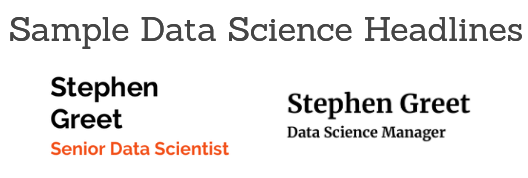

What skills belong on a data science resume?
Only include skills you’d be confident in and defend during an interview. Recruiters can tell “skill vomit” at a glance.
Even if you don’t have a college degree, your skills may get you hired—so you want to make the most of this section.
The most common mistake we see on data science resumes (that we used to make on our resumes) is what we call skill vomit. It’s a laundry list of skills in which no one person could have expertise. A quick rule of thumb: if the skills section takes up a third of the page, it’s a big red flag for hiring managers.
The reason people make such an exhaustive skills section is to get through the keyword filters. If you’re changing your resume in small ways for each job you apply to (for example, put Python for jobs that mention Python and R for jobs that list R if you know both), you’ll have no problem with those keyword filters.
The rule of thumb that we recommend you use in determining whether to include a skill on your resume is this: if it’s on your resume, you should be comfortable coding with/in it during an interview.
So that means if you’ve read a few articles on Spark or adversarial learning, but you can’t use them in code, they should not be on your resume. If you only have a handful of tools under your toolbelt, but you can use them effectively to answer questions with data, you’ll be able to find jobs looking for that skill set.
We can assure you there are all kinds of data science jobs available. Our scraper that indexes jobs across thousands of company websites shows over 5,000+ full-time data science job openings in the US across all tenures and skill sets. And our scraper has a lot of room for improvement, so that’s significantly lower than the actual number.
There are tons of fish in the job market sea; you just need a fishing rod.
Do list:
- Python, SQL, pandas, scikit-learn, matplotlib
- Key libraries: XGBoost, Dask
- Cloud tools: AWS, GCP
Don’t list:
- Buzzwords that you only know in theory
- Special skills, unless you’re fluent in them, are in demand in the job description

Entry-level vs. senior skills sections
Generally, the more senior you are, the shorter your skills section needs to be. If you’re a senior data scientist, you should talk about the major tools and languages you use but save specific modeling techniques for the “Work Experience” section. Show how you used particular models in the context of your work.
When you’re more junior, you likely haven’t had the chance to use all of the techniques you’re comfortable with within work or a project. That’s okay! It’s expected. But you still want to make it clear to a potential employer that you can use those methods or libraries.
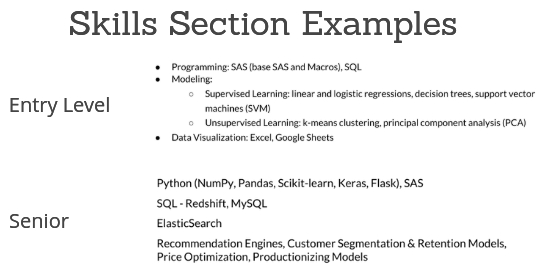

Essential soft skills for data scientists
While technical skills say you know the job, soft skills help you succeed by communicating and working with teams effectively.
Most-preferred soft skills in data science resumes:
- Communication: Presentations, delivering goals and results
- Problem-Solving: ask and respond to business questions in the best way possible
- Initiative: Do you use a proactive approach in finding insights?
- Collaboration: Can you team up with product, engineering, and marketing for common goals?
Don’t just list these skills; put them in context within your work bullet points as in the example below:
Example
Partnered with the product team to define experiment goals, resulting in a 12% feature adoption lift = teamwork, and excellent communication

How to list education for data scientists
Education is a lot like skills in that the more senior you are as a data scientist, the less space the education section should take up on your resume. When you’re looking for one of your first data science jobs, you might want to include courses relative to data science to demonstrate you have a strong foundation.
Classes in subjects like linear algebra, calculus, probability, and statistics and any programming classes are directly relevant to being a data scientist. If you’re looking for your first job out of college, you should include your GPA on your resume. When you have a few years of work experience, it’s not necessary to include it.
If you just finished (or are finishing) a data science boot camp, this is the place to list where you went. You can include the relevant lessons or classes you took. Be sure to have a few projects from your boot camp (especially if it was an original project) in your resume’s “Projects” section.
The education section should include:
- Field of study (e.g., B.S. in Computer Science)
- College/university’s name
- Years attended
- Location: city and state
- Relevant coursework (if entry-level)
- GPA (only if recent and >3.5)
Example:
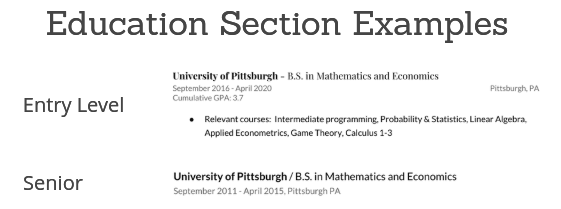

How to add your contact information
The takeaway from this section is simple: this is not where you should make a mistake. Storytime! When our co-founder was first applying to jobs out of college, he realized about 20 applications in, he had spelled his name “Stepen” instead of “Stephen.” Don’t pull a Stepen.
Data suggests that when your email is wrong, your response rate from companies drops to zero percent. That’s just math. We’ve seen exactly four data science resumes where the email address on the resume was incorrect.
Make sure your email address is appropriate. While we don’t doubt the authenticity of your “[email protected]” email, maybe don’t use it when applying for jobs. To play it safe, stick to a combination of your name and numbers for your email.
This is the section you can include anything you want to show off for a data science role. Have a blog where you document the analysis you do for Dungeons & Dragons? Active on Github or an open-source project? Include a link to anything relevant to data that will help you stand out in your application.

General resume formatting tips
This section is just a list of one-off styling and formatting tips for your data science resume:
- Keep it brief. Bullets should be informative but should not drag on for paragraphs.
- Each bullet point in your resume should be a complete thought. You don’t have to have periods at the end of each bullet.
- Keep your tense consistent. If you’re referring to old projects in the past tense, do that for all old projects.
- Please, please don’t get your contact information wrong.
- Use Grammarly or similar to check the spelling and grammar in your resume. Then do that two more times. Finally, have someone else review it just for spelling and grammar.
- Don’t give the person reviewing your resume a silly reason to put it in the “No” pile. Check your resume carefully.

How to customize your resume for each job
You don’t need an overhaul, but a few edits to suit your resume for each role.
How to customize:
- Use the exact job title in your resume headline
- Let your projects use as many keywords from the job description as possible
- Fill your skills section with the tools that the potential employer lists
- If applicable in your case, showcase domain overlap in your bullet points(e.g., marketing, healthcare, fintech)
Pro tip: Create a Python-focused and R-focused version of your resume if you’re an expert in both and swap copies depending on the role.
Here are the steps we recommend to customize it for each job:
- Ensure that for each language you have extensive experience in (Python and R, for example), you have separate resumes emphasizing specific projects in each language.
- So in this example, we’ll have one “Python” resume and one “R” resume depending on what the job is seeking.
- Read the data scientist job description. Do any specific projects you worked on come to mind as you read it? If so, include those projects as bullet points on your resume. Here are some sample questions to help you think of specific projects to list for different jobs:
- For example, if you have experience with attribution modeling and this is a marketing data science role, you should include that experience.
- Do you have experience with a certain library or modeling technique they mention?
- Do you have experience in the domain of the specific job?
- Do you have any relevant industry experience with the company?
Let’s walk through a specific example to highlight what we mean by including particular projects for different jobs. Let’s say that a senior data scientist is applying for the position below.
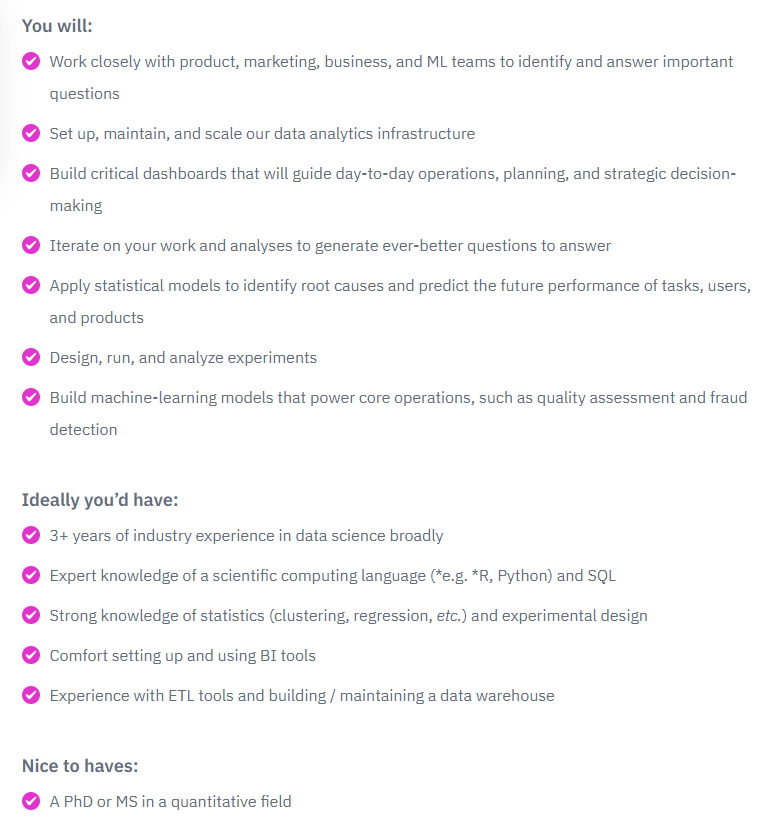
In the “Ideally, you’d have” section, they mention they want someone who has “Experience with ETL tools.” Let’s say that in reality, the candidate had a large role in building out data pipelines in his fictional role as a senior data scientist at EdTech Company.
So all we’d do is change that section of his experience at EdTech Company to talk about that project, as you see below:
Data science resume customization example
Original bullet on the resume: Worked closely with the product team to build a production recommendation engine in Python that improved the average length on the page for users and resulted in $325k in incremental annual revenue
Customized for the role: Built out our company’s ETL pipeline with Airflow, which scaled to handle millions of concurrent users with robust alerting/ monitoring

How to customize your data science resume for startups
For early-stage startups (anything less than 50 employees), one of the most important qualities they’re looking for in a hire is ownership. That means they want someone who can ask a question and come up with an answer with minimal instruction.
If you want to stand out to these companies, you should demonstrate ownership in the way you list projects on your resume. Include active words like “drove” or “built” instead of passive language like “worked on” or “collaborated on.” We know this seems nit-picky, but this matters to early-stage companies. Hiring managers at companies this size are strained for time and will use any signal to weed people out.

Resume tips for data science bootcamp grads
For a bootcamp graduate, lean more on your projects for credentials.
To showcase them well, include:
- Bootcamp name, when, and where
- Relevant tools/languages learned
- Capstone project with clear impact—results, audience, and tech used
- GitHub
Example project bullet:
- Built a movie recommender system using collaborative filtering in Python with Scikit-learn, which saved 22 minutes per session and reached 96% satisfaction in user tests.

Common mistakes to avoid on a data scientist resume
Regardless of how strong a candidate you are, you can lose interviews over these avoidable mistakes:
- No quantified results
- Stuffed skills section
- Inconsistent formatting
- Wrong or missing contact info
- Generic content without focus on the specific role

Concluding thoughts
There you have it—a compelling, easy-to-read data science resume built for 2026. Now you can celebrate by doing something as fun as writing a resume. Maybe your taxes? Or go to the dentist?
By building or updating your current resume, you took a huge step toward landing your next (or first) data science job. Now please, we beg you, check your grammar and spelling again and have someone else read your resume. Don’t let that be the reason you don’t get an interview.
Congrats! The first and hardest step is done. You have a data science resume! With great power comes great responsibility, so go and apply wisely.
Land your next job with our AI-powered, user-friendly tool.
Gut the guesswork in your job hunt. Upload your existing resume to check your score and make improvements. Build a resume with one of our eye-catching, recruiter-friendly templates.
• Work in real-time with immediate feedback and tips from our AI-powered experience.
• Leverage thousands of pre-written, job-specific bullet points.
• Edit your resume in-line like a Google Doc or let us walk you through each section at a time.
• Enjoy peace of mind with our money-back guarantee and 5-star customer support.
Data Scientist Resume FAQs

A data scientist resume must list and use technical, statistical, and communication skills. Show evidence of using these core tools/skills:
Python
NumPy
TensorFlow
Power BI
Storytelling with data
Stakeholder communication
GCP
Always keep your resume to one page, unless:
You have 10+ years of experience
You’ve published papers or patents
You’re applying for a role in academia or research
Pro tip: For most roles, relevance > completeness. Leave out projects or skills that don’t match the job.
A high-performing data scientist job description = clarity + context + niche/industry keywords.
As much as possible, include these elements:
Role overview
Key duties
Required stack
Team/leadership context
Outcomes + impact
Example:
Developed predictive churn models for a telecom SaaS platform, using Python, scikit-learn, and Snowflake, collaborating with CX and CRM teams, resulting in a 22% reduction in customer churn over 6 months.
Present your data scientist resume in a clean, ATS-optimized format that prioritizes technical credibility and project impact.
Follow this structure:
Single-column layout
Consistent fonts and spacing
Standard headers— Contact, Experience, Skills, Projects, Education, Certification, etc.
In PDF or DOC unless otherwise stated




